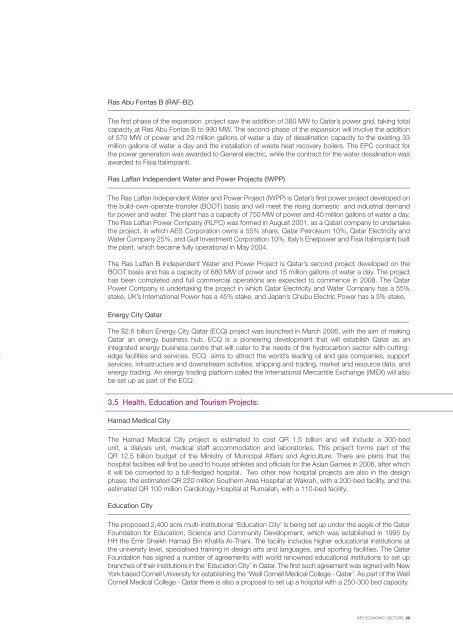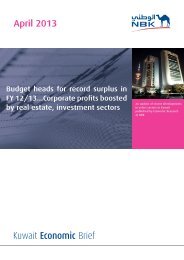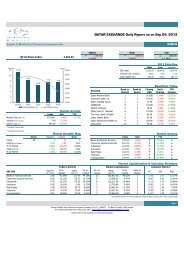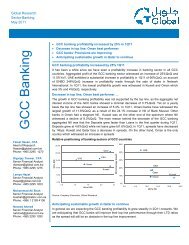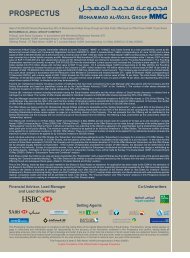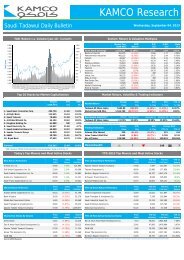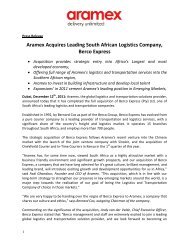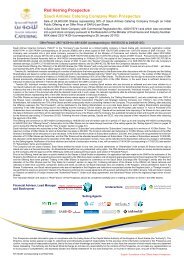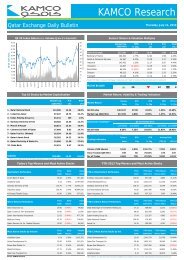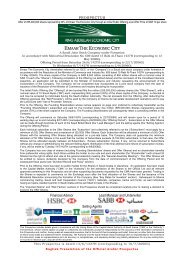Qatar Economic Review 2006(September) - QNB
Qatar Economic Review 2006(September) - QNB
Qatar Economic Review 2006(September) - QNB
You also want an ePaper? Increase the reach of your titles
YUMPU automatically turns print PDFs into web optimized ePapers that Google loves.
Ras Abu Fontas B (RAF-B2)The first phase of the expansion project saw the addition of 380 MW to <strong>Qatar</strong>’s power grid, taking totalcapacity at Ras Abu Fontas B to 990 MW. The second-phase of the expansion will involve the additionof 570 MW of power and 29 million gallons of water a day of desalination capacity to the existing 33million gallons of water a day and the installation of waste heat recovery boilers. The EPC contract forthe power generation was awarded to General electric, while the contract for the water desalination wasawarded to Fisia Italimpianti.Ras Laffan Independent Water and Power Projects (IWPP)The Ras Laffan Independent Water and Power Project (IWPP) is <strong>Qatar</strong>’s first power project developed onthe build-own-operate-transfer (BOOT) basis and will meet the rising domestic and industrial demandfor power and water. The plant has a capacity of 750 MW of power and 40 million gallons of water a day.The Ras Laffan Power Company (RLPC) was formed in August 2001, as a <strong>Qatar</strong>i company to undertakethe project, in which AES Corporation owns a 55% share, <strong>Qatar</strong> Petroleum 10%, <strong>Qatar</strong> Electricity andWater Company 25%, and Gulf Investment Corporation 10%. Italy’s Enelpower and Fisia Italimpianti builtthe plant, which became fully operational in May 2004.The Ras Laffan B Independent Water and Power Project is <strong>Qatar</strong>’s second project developed on theBOOT basis and has a capacity of 680 MW of power and 15 million gallons of water a day. The projecthas been completed and full commercial operations are expected to commence in 2008. The <strong>Qatar</strong>Power Company is undertaking the project in which <strong>Qatar</strong> Electricity and Water Company has a 55%stake, UK’s International Power has a 45% stake, and Japan’s Chubu Electric Power has a 5% stake.Energy City <strong>Qatar</strong>The $2.6 billion Energy City <strong>Qatar</strong> (ECQ) project was launched in March <strong>2006</strong>, with the aim of making<strong>Qatar</strong> an energy business hub. ECQ is a pioneering development that will establish <strong>Qatar</strong> as anintegrated energy business centre that will cater to the needs of the hydrocarbon sector with cuttingedgefacilities and services. ECQ aims to attract the world’s leading oil and gas companies, supportservices, infrastructure and downstream activities, shipping and trading, market and resource data, andenergy trading. An energy trading platform called the International Mercantile Exchange (IMEX) will alsobe set up as part of the ECQ.3.5 Health, Education and Tourism Projects:Hamad Medical CityThe Hamad Medical City project is estimated to cost QR 1.5 billion and will include a 300-bedunit, a dialysis unit, medical staff accommodation and laboratories. This project forms part of theQR 12.5 billion budget of the Ministry of Municipal Affairs and Agriculture. There are plans that thehospital facilities will first be used to house athletes and officials for the Asian Games in <strong>2006</strong>, after whichit will be converted to a full-fledged hospital. Two other new hospital projects are also in the designphase; the estimated QR 220 million Southern Area Hospital at Wakrah, with a 200-bed facility, and theestimated QR 100 million Cardiology Hospital at Rumailah, with a 110-bed facility.Education CityThe proposed 2,400 acre multi-institutional ‘Education City’ is being set up under the aegis of the <strong>Qatar</strong>Foundation for Education, Science and Community Development, which was established in 1995 byHH the Emir Sheikh Hamad Bin Khalifa Al-Thani. The facility includes higher educational institutions atthe university level, specialised training in design arts and languages, and sporting facilities. The <strong>Qatar</strong>Foundation has signed a number of agreements with world renowned educational institutions to set upbranches of their institutions in the ‘Education City’ in <strong>Qatar</strong>. The first such agreement was signed with NewYork based Cornell University for establishing the ‘Weill Cornell Medical College - <strong>Qatar</strong>’. As part of the WeillCornell Medical College - <strong>Qatar</strong> there is also a proposal to set up a hospital with a 250-300 bed capacity.KEY ECONOMIC SECTORS 29


